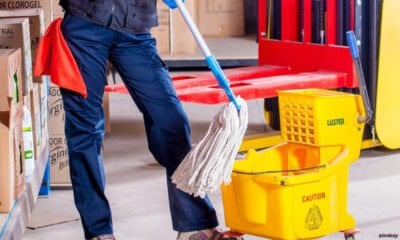General
Cleaning During Coronavirus: 6 Best Disinfecting Tips

Keeping a clean environment is more important now than ever. With everyone trying to keep safe from the threat of COVID-19, you might be wondering about the best virus removal tactics for your own home, especially now you’re spending more time in it working remotely.
While keeping a clean space is always important, you might be focused on extra precautions now, especially if you’re in one area that is beginning to open up during the pandemic. It’s never a bad idea to stay clean!
If you’re looking for tips to get that home office spotless, especially for your Zoom video conferencing, you’ve come to the right place! Our tips will help you get ahead of the things that make us ill, starting with your surfaces. How clean is your work desk?
1. Clean First, Then Disinfect
When you’re working on improving your cleaning skillset, you’ll have to keep one thing in mind: cleaning and disinfecting are not the same.
Disinfecting will kill the germs and bacteria lurking in your home and office. Gross!
Cleaning is a much more surface-level process.
These are both important, but you’re going to keep them both in mind.
When you get to work on one area, make sure that you’re cleaning first (or removing surface-level dirt and debris) and then disinfecting with solutions.
2. Clean More Frequently
You might be used to only cleaning once every other week or so, perhaps less for your hard surfaces, like your work desk.
Try to make disinfecting high-contact non-porous surfaces a daily habit.
What’s a high contact surface?
A high-contact surface will get a lot of use throughout your day! These will be things like doorknobs, stovetops, handles, tables, remote controls, light switches, frequently-opened windows, and your keyboard and mouse at your home office workstation.
Anything that sees a lot of hands should also see a lot of cleansers.
You might think that you’re overdoing it. That’s okay! It’s better to overdo it for a little while than to underdo it and end up with a sick household.
3. Wear Necessary Protective Gear
When you’re cleaning more often, you might come into contact with abrasive chemicals.
It’s always good advice to wear single-use gloves to clean. If you don’t like the idea of single-use products, use gloves that only have a household cleaning purpose and ensure that they don’t get mixed in with gloves that you might use elsewhere.
Some chemicals can be abrasive to the eyes. If you start using these, it can be helpful to wear protective eyewear.
You may notice your hands getting irritated from the increased cleaning, even despite the gloves. After every cleaning session, you should still be careful about washing your hands.
When you’re done, to help prevent dryness, moisturize your hands and let them rest, so you’re ready to get back to it tomorrow.
4. Try a Bleach or Alcohol Solution
When you started cleaning for the coronavirus, you may have noticed something upsetting: many cleaning solutions were out of stock.
While more and more grocery stores are doing a great job at keeping their essential cleaning supplies stocked, there are other options for cleaning. Some of them use products you may already have at home (though many of these also went missing when shelves went bare!).
Bleach solutions have to be heavily diluted. Bleach is serious stuff! This means that it has lasting power in your home.
You’re looking for a concentration of 5%-6% depending on what you’re looking to disinfect (and you can always double-check the surface that you’re disinfecting online to ensure that bleach is a suitable choice).
Concentration is partially dictated by the amount of sodium hypochlorite in your product.
This means you may be using as little as 1/3 of a cup of bleach in an entire gallon of water.
This might not seem like enough, but bleach is powerful and can be dangerous if used in too high of a concentration.
Alcohol is also a good choice. A product needs roughly 70% (or more) alcohol to be effective.
If you have a lower % alcohol product that you then dilute with water, it will not be an effective cleaner. Be sure to read your labels.
5. Actually Read Your Instructions
Reading labels is important.
You might notice, when you actually read, that some of those labels say that you must leave your disinfectants on the surfaces for several minutes to be effective.
This may vary by the product.
It’s widespread to simply spray a cleaner onto a surface and wipe it away in hopes that it has done its job. In reality, when you’re working with a potential virus, this isn’t good enough.
The best virus removal tip is also the easiest: you need to read the instructions on the packages.
6. Don’t Forget Your Phone
How many things do your phone touch every day?
Does it also touch your mouth? Does it ever touch public spaces? Has it fallen on the ground?
Realistically, your phone is covered in germs.
Are all of them COVID-19 threats? Probably not. It’s still in your best interest to give your phone a good wipe-down with an alcohol wipe before setting it on your freshly-cleaned household surfaces.
What’s the point if you place a germ-ridden object onto a sanitized one?
Keep yourself safer by keeping your phone as sanitary as your home.
What Are Your Best Virus Removal Tips?
The coronavirus pandemic has taught a lot of people that their previous disinfecting methods may not have been good enough. This is a good thing!
Working from home now means it’s up to you not the office cleaners to your work environment safe.
For more posts like this, visit the rest of our site.




